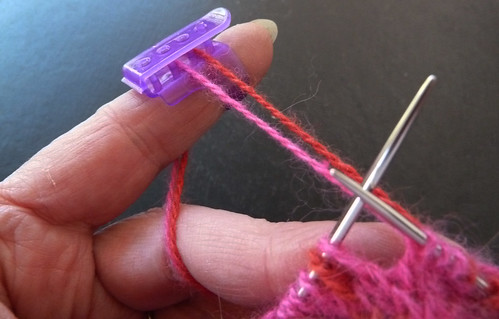The very first sweater I ever made was a multi-colored
Norwegian, at the tender age of eight years old. It still fits!
My mother ordered a kit from Norway, because
in those long-ago days, yarn selection was limited, and the color range was
even worse. Knitters of a certain age will recall, and not fondly, that odd brick red and the peculiar pea-soup green that were all the rage back in the Fifties...
I remember being entranced when the package arrived—what lovely shades
of clear blue! The yarns were a somewhat harsh worsted weight and the
directions copious—lots of diagrams, pictures, charts, arrows, and paragraphs
of explanation. Too bad they were all in Norwegian.
Fortunately, a neighboring couple hailed from the
Old Country. I used to spend many afternoons in their kitchen appraising
traditional Norwegian cookies (Delicious!) and avoiding traditional Norwegian
Lutefisk (Not Delicious!). Made from dried whitefish and lye, Lutefisk has a repulsive
gelatinous texture and an indescribable odor. The only substance that can
approach Lutefisk is a dried Japanese fish called Aji, whose aroma is so, um,
ghastly that as soon as I saw the depressing little flatfish being removed from
the freezer where we lived in Japan,
I slunk out to the bus stop and had dinner in town.
Anyway, my mother and I hiked down to the Jensens’ with the
pattern and yarn, and Mrs. Jensen explained, partly in Norwegian with lots of gestures, how to make
the sweater. Following the directions included learning Norwegian purling and knitting with one
yarn in the right hand. I found it
awkward and annoying, but persevered, and after a while, the sweater was
finished and I had a working knowledge of knitting English-style. I never did
figure out how to purl that way.
Over the years, when confronted with multiple colors, I
defaulted to the two-handed method. I still found it awkward and annoying, so a
few weeks ago, I decided it was time to master the one-handed technique, that
is, knitting with two colors in my left hand.
I dutifully watched all the
YouTube videos, and was amazed at how easy it looked. However, to my great annoyance, the actual trick of winding the yarns onto the fingers for
tensioning was always performed at The Speed of Light, or the camera was
focused on the knitting instead of the hands, or someone smeared Vaseline on
the camera lens as soon as it moved over to record the tensioning trick.
NOTE: If a Two-Color-Left-Hand
video knitter is reading this, please repost the video with a slo-mo of the
tensioning step. Yeah! Thanks!
I spent a week tangling the yarn around various fingers. At
one point, I somehow wrapped the yarns in such a way that I created one of
those Chinese Finger Trap toy thingies. Harry snickered, Laptop rolled her eyes, Rambo flipped her ears, and I said things that cannot be written in this blog because it’s G-Rated and I am not supposed to know those words, anyway. Roy was out of the house,
so I was at least spared his chortling.
After snipping the yarns off my fingers, I threw in the
metaphorical towel and went hunting for The Knitting Accessory of Shame,
purchased years ago and never actually used beyond a brief, and unsuccessful, trial period. I finally
located the thing in a cigar box full of straws (don’t ask), placed it on the
index finger of my left hand, and, after a few minutes of practice, discovered
that it actually worked quite well. It’s liberating!
For comparison, I bought the KnitPicks version—it’s a
plastic ring with dividers—lightweight and rather cleverly designed.
The trick to using these yarn guides is to practice with a
single yarn first, before adding the second one. Each guide has a sweet spot on
your finger—you’ll have to experiment and find the position that suits you
best. For example, the metal guide’s picture always shows it sitting straight
up, with the yarns coming off the top. For me, turning the rings so that they
face front worked much better. I also found that putting the yarns on the floor
was a great help—the slight gravitational pull prevented the yarns from
tangling.
The KnitPick’s guide is very tight and the plastic edge a
bit sharp. I’m probably going to give it a coating of nail polish to smooth it
out and hope that using it loosens the band a little. People with large fingers
may have to pre-stretch it on something—a wooden dowel, for example-- before it
fits comfortably.
I realize that Real Knitters don’t use yarn guides and that
yarn guides cannot be taken to S&B’s because everyone will laugh at you or
give you that pitying, condescending look implying you also use training wheels
on your bike and sometimes knit with acrylic. So, the answer is to take one-color
knitting to the S&B and in the privacy of your home, create lovely Fair
Isle, Scandinavian, Estonian, and Bohus colorwork with perfectly even tension
at a speed only slightly slower than a single color.
 |
| Pink Sago Palm Bohus from http://www.solsilke.se/ |





